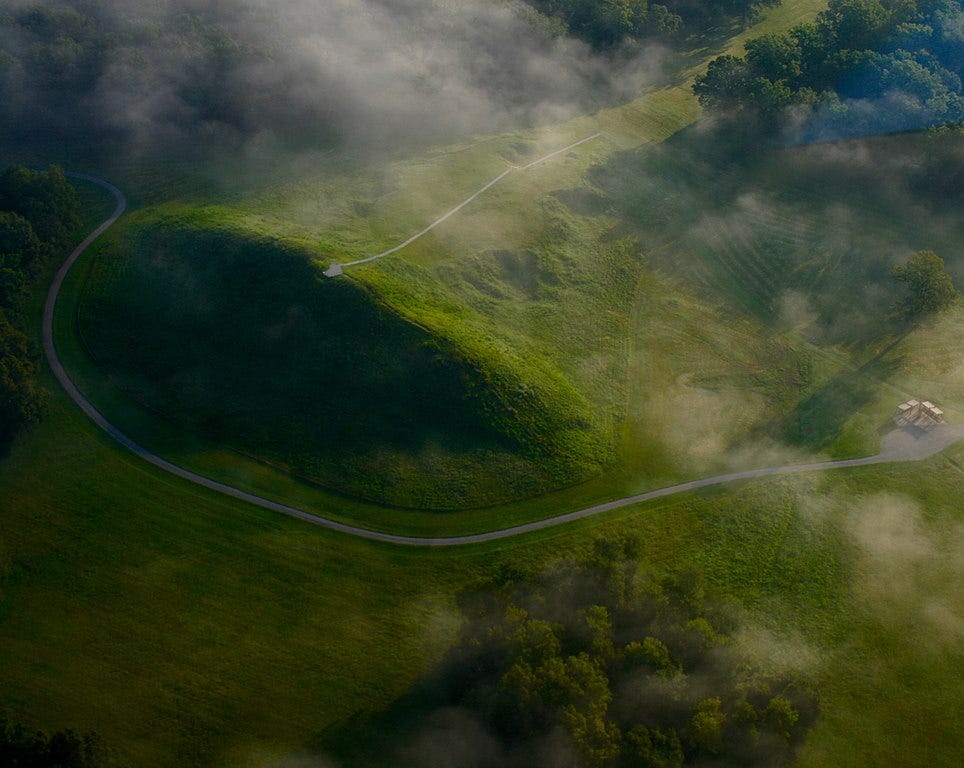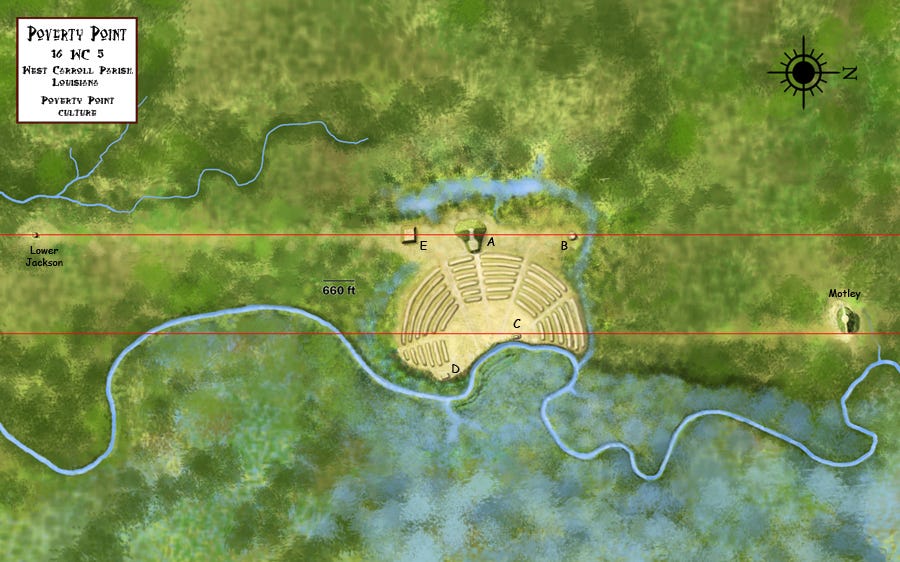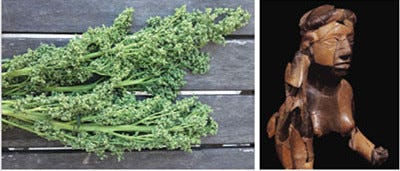Pin Drop: Poverty Point
In the flat farmlands of northern Louisiana, the place where North America changed entirely

The Osage, who for centuries lived along the Osage River, call themselves Ni-u-kon-ska, or “Children of the Middle Waters.” These Middle Waters pour northward into the Missouri. Not far to the south lies the Red River. This is the region where the Midwest and the Great Plains and the Ozarks all blur together.
But the Osage also tell stories of the swamps.
The being who taught Osage women how to farm was Old-Woman-Who-Never-Dies. She is associated with the Lower World, a wet and tumultuous place, and with the Mississippi River in particular: according to the legends, she lives on an island near the river’s mouth, at the edge of the Gulf of Mexico, where she was protected by a water snake—from whose body she coaxed the first sunflowers and squash.
Call me biased, but to me this offers evidence of just how important this river and its wetlands are.
Last week, Emergence published a long essay I wrote about Indigenous earthworks, which I hope you’ll take the time to read.
Mounds can be found across the continent in various forms, but, as I note in the essay, nowhere are they found in denser concentrations than along the Mississippi River and its tributaries. The Cahokia mounds, in Illinois, are particularly famous, as are the effigy mounds in Iowa, which are preserved in a national park. But what I see as the potentially the most important earthwork on the continent is little known—even, I’ve found, to people who live within a day’s drive of the site. Here, I want to focus on that place: Poverty Point, in northern Louisiana.

Poverty Point is centered around a large plaza, which overlooks Bayou Macon—and, beyond that, the vast expanse of river swamplands. Back when Poverty Point began, the cypress forest must have seemed endless, stretching hundreds of miles to the north. The plaza is delineated by a series of concentric half-ring ridges; behind these ridges rise a series of mounds, including one that stands 72 feet tall.
That name, with its suggestion of deprivation and suffering, is ironic. Most likely it’s drawn from a plantation that was built here and that never amounted to much. Today, the surrounding region, the alluvial flatlands in north Louisiana, does struggle with poverty. But 3,700 years ago years ago, when ancient people built the mounds at Poverty Point, it must have been the most prosperous site on the continent.
Archeologists have found trade goods carried from across much of the Mississippi’s watershed. The list includes, as I note in Emergence,
Galena rock from Iowa and Missouri, Pickwick chert from Tennessee, flint from Indiana. Red jasper pendants carved in the shape of pot-bellied owls were carried away from Poverty Point, to sites as far afield as Florida. Someone buried more than 250 shattered bowls and vessels here; the heavy soapstone was almost certainly carried by water, which would have required a voyage of more than eight hundred miles, including a long passage along the edge of the Gulf of Mexico.
The mounds themselves appear to have been built in ninety days, perhaps even faster—a task that would have required a team of at least two thousand. The scale of this place long befuddled archeologists, who presumed at first that it must have been around a thousand years old, built by people who had already learned how to farm. This was, it’s clear, the most important place anywhere in North America at the time that it was built.
It’s impossible to know what the people who built Poverty Point meant to convey with these monuments, but I’m compelled by a theory developed by archeologist Ken Sassaman. Most Indigenous cultures in the Southeast—and most of the cultures who built (and build) earthworks—conceive of a cosmos that includes a swampy and chaotic Lower World and an orderly Upper World. Sassaman points out the U.S. landscape, as split by the Mississippi River, matches this cosmos: you’ve got a tempestuous gulf to the south, hills and ridges to the north.
Poverty Point was built on the edges of the big river’s valley, overlooking the swamps, reaching toward the sky. He supposes, then, that Poverty Point may have been a portal to the Lower World—down the place where, in North America, everything began.
Forgive me as I go out on a limb here, but there is reason to believe that the first people to live in the Southeast arrived not by trekking overland from the Bering Straight, but by traveling along coastlines. There’s archeological evidence showing that people passed eastward along the edge of the Gulf of Mexico—presumably after crossing the continent somewhere in Mexico—14,000 years ago, before the glaciers fully receded, before the Mississippi River as we know it even formed.
The continent’s first earthworks appeared to the east, in Florida, and were made of shells. But the first truly massive complexes of earthworks all appeared along the edges of the Mississippi’s southern swampy valley. This makes sense to me: the rich soils and endless waterways make this a good place for easy living. There are deer to hunt and fish to catch and pawpaws to harvest in the woods.
The earliest mounds built along the Mississippi River were plenty impressive. The largest includes eleven earthworks, all linked by a low embankment. Generations of people built these over a period that spanned 600 years. But this achievement pales in comparison to what happened at Poverty Point.
Western culture sometimes looks at civilization as a process of peeling ourselves away from “the wilderness”: we settle into villages; we domesticate crops; great things emerge. Here in North America, though, the first great cultures did not begin by taming the wilderness. They flourished within the wilderness along the Mississippi River—because of the wilderness, really.1
For thousands of years, people seemed to remember this. Moundbuilding eventually jumped upriver, flourishing in, among other places, the Ohio Valley where the Osage and other western people once lived. The ancestors of the Osage likely lived at Cahokia, near modern St. Louis, where the largest mound in the U.S. was built. Archeologists have found figurines at Cahokia that appear to honor Old-Woman-Who-Never-Dies. It’s as if everyone was always looking back south toward the life-giving swamps.

I know people who feel a kind of spiritual awe in the presence of earthworks. I wish I did. Perhaps I lack the appropriate imagination. The surrounding region is far from scenic: just empty highways running through emptier fields. It’s hard for me to conjure the people who built these monuments.
Still, it’s a pilgrimage I recommend to anyone. Wetlands have never meant much to modern Americans—“drain the swamp!” we like to say—and here is a reminder of another way of thinking.
If you go
Poverty Point is, as I’ve noted, not exactly in the midst of a highly trafficked tourist zone. Fortunately, there’s a state park just south of the site, where you can camp, or if you’re looking for something less rustic, stay in a cabin. There’s not much I can recommend in the way of food, but the Delhi Little Grill looks promising. (Report back if you make it!)
I will recommend a few books to read on your voyage.
First: Casey Parks’ Diary of a Misfit: A Memoir and a Mystery, which has nothing to do with the mounds themselves, but offers a portrait of life in the modern landscape here. (Casey stayed at the state park during much of her research, as you’ll see.)
Second: Phillip Carroll Morgan’s Anompolichi: The Wordmaster, a young adult novel by a Choctaw/Chickasaw writer. Morgan offers a fictionalized vision of the Mississippian era, which is thousands of years after Poverty Point’s creation, but until I read this book I hadn’t realized how palely I’d imagined the Southeast in the era before colonists arrived.
It turns out that this is not just the case in North America. In the Middle East and Africa, some of the first sedentary communities were settled by nonagricultural people and situated, just like the Mississippi mound sites, on the edge of wetlands. These were ecotones, border zones, where hunting-and-gathering people could access the resources of multiple ecosystems and therefore not worry about if something—say a flood—caused problems in one.




